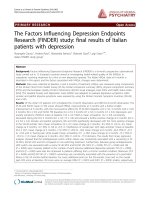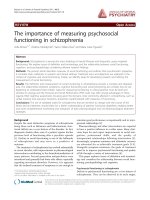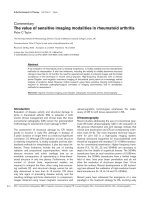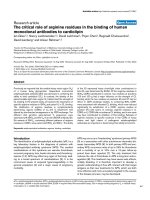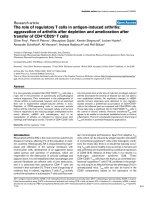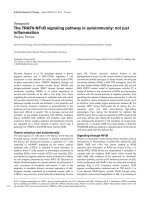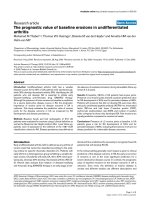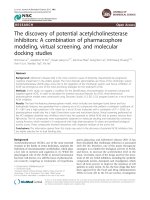Báo cáo y học: "The International Sepsis Forum’s controversies in sepsis: how will sepsis be treated in 2051" doc
Bạn đang xem bản rút gọn của tài liệu. Xem và tải ngay bản đầy đủ của tài liệu tại đây (38.76 KB, 3 trang )
465
ICU = intensive care unit; IL = interleukin; TLR = Toll-like receptor.
Available online />It is a sobering experience to be faced with a blank page and
to be asked to speculate on what we might be doing
49 years from now. I will not be treating sepsis in 2051
because I won’t be here. The chances are, however, that
future intensivists will not really be treating ‘sepsis’ either. Let
me explain.
By the middle of the 21st century we will finally have a
definition of sepsis. For instance, this is what you might read
in the 2048 edition of a medical dictionary:
sepsis (sep
·
sis). A generic term that describes a group of diseases
that result from the systemic expression of acute inflammation.
By then, the epidemiology of sepsis will have changed;
sepsis will be more common because it is an iatrogenic
disorder – a consequence of the successes that we have
had in critical care medicine. However, mortality will have
decreased profoundly, partly because of new therapies and
partly because we will understand the pathophysiology
better. Depending on the stage of sepsis, mortality will be no
more than 5%, in large part because we will finally accept
that it is legitimate to die from natural causes, and those
deaths will no longer be attributed to sepsis.
Changing our perception of infection
Today our tools for the diagnosis of infection are limited to
microbial cultures, radiologic investigations, and direct
examination. Selecting appropriate antibiotic therapy is
difficult because culture and sensitivity data are not
immediately available. It is not difficult to imagine, however,
that in the future we will have rapid point of care diagnostic
technology based on detecting microbial products and even
antibiotic resistance genes.
At present we see the microbial world as largely inimical, and
we take extraordinary measures to eradicate it. In the future
we will have a better understanding of ‘host–microbial
Commentary
The International Sepsis Forum’s controversies in sepsis: how
will sepsis be treated in 2051?
John C Marshall
Professor of Surgery, University of Toronto, General and Critical Care Surgery, Toronto General Hospital, Toronto, Ontario, Canada
Correspondence: John C Marshall,
Published online: 17 July 2002 Critical Care 2002, 6:465-467 (DOI 10.1186/cc1539)
This article is online at />© 2002 BioMed Central Ltd (Print ISSN 1364-8535; Online ISSN 1466-609X)
This article is based on a presentation at the 31st Annual Congress of the Society of Critical Care Medicine (SCCM), San Diego, California, USA,
26–30 January 2002. The presentation was supported by the International Sepsis Forum (ISF).
Abstract
Sepsis, the life-threatening illness that arises from innate immunity to overwhelming infection, is treated
symptomatically at the start of the 21st century. Looking ahead 50 years, one can perhaps foresee
profound changes in the way we manage this disorder. A shift from a focus on eradicating micro-
organisms as universally inimical to one on supporting optimal host–microbial homeostasis will have a
profound impact on how we treat infection, and will relegate antibiotics to a small, adjuvant role.
Probiotic therapy may well be as important as antibiotic therapy. Resuscitation strategies will support
microvascular flow rather than systemic pressure. Rapid genetic profiling will permit pre-emptive gene
therapy for some, and titration of specific therapies directed against fundamental intracellular
processes in others. We will treat diseases, not syndromes, and guide therapy by molecular staging. A
fanciful victim of sepsis in 2051 illustrates how future treatments might transform sepsis from a
prolonged and morbid illness to a rapidly reversed acute disease.
Keywords host–microbial interactions, infection, polymorphisms, probiotics
466
Critical Care December 2002 Vol 6 No 6 Marshall
symbiosis’. We will understand that the successful treatment
of infection is grounded not just in eliminating a pathogen but
also in supporting the indigenous flora of the host. We will
administer micro-organisms as often as we will kill them. We
will change the way we use antibiotics. We will understand
that antibiotics kill micro-organisms, and will only use
antibiotics when we have clear evidence that there are viable
pathogenic organisms present. A typical course of antibiotics
will last no more than 12–24 hours, and we will guide the
duration of treatment by specific viability assays.
As we improve our understanding of the role that the
indigenous flora play in maintaining physiologic homeostasis,
we will develop the science of ‘probiotics’, recalling, for
example, a landmark study from the late 20th century. A strain
of a relatively avirulent organism was genetically engineered to
produce IL-10 and was fed to mice with experimentally
induced colitis [1]. When the colitis flared up, transit through
the gut decreased, resulting in increased bacterial numbers.
This in turn led to increased secretion of IL-10 and resolution
of the acute inflammatory process. That study will have set the
stage for an entire class of therapeutics, using bacteria as
drug delivery systems and using the kinetics of bacterial
growth as a mechanism for titrating therapy.
Yet another approach to limiting inflammation will derive from
the recognition that bacteria contribute to the termination of
an inflammatory response by inducing the apoptosis or
programmed cell death of the neutrophil. Work from the past
century established the principle. Sookhai and coworkers [2]
subjected rats to intestinal ischemia/reperfusion injury, and
showed improved survival when killed Escherichia coli were
simultaneously administered down the trachea. The bacteria
induced apoptosis in neutrophils that had migrated into the
lung, lessening the acute lung injury and significantly
enhancing survival of the animals. If infection is a potent
stimulus to limit inflammation, then in the future we may well
believe that patients die from the absence of infection as
often as from its presence.
Image-guided surgery
Today we are witnessing the merging of two technologies
with roots that are quite divergent, namely minimally invasive
surgery and radiology. As these technologies advance, the
distinction between them is becoming blurred. The challenge
for today’s surgeon is to learn how to image, whereas the
challenge for today’s radiologist is to learn how to perform
the surgery. In the future these skills will be combined.
Surgery will become less invasive as imaging techniques
become more revealing.
Indeed, the next frontier in imaging will be to reveal not only
anatomy but also physiology and biochemistry. In the future
we will be able to image cellular metabolism noninvasively,
and to make clinical decisions on the basis of dynamic
visualization of cellular function.
Resuscitation
At the start of the 21st century we debated the relative merits
of differing vasopressor strategies in septic shock. In the
future we will shift our focus to vasodilator therapy,
recognizing that normalization of blood pressure is only
achieved at the cost of a profound reduction in flow in the
microvasculature. We will realize that measurement of
pressure is a poor surrogate for optimization of flow, and will
resuscitate patients on the basis of direct visualization of flow
in microvascular beds. This new philosophy of ‘permissive
hypotension’ will be based on the recognition that the
reduced peripheral vascular resistance of sepsis is an
appropriate adaptive mechanism to be supported, rather than
a disease to be reversed.
Specific therapy for sepsis
We will have a large number of adjuvant therapies that target
the host response. However, rather than target individual
mediators, we will treat the underlying cellular derangements
of critical illness: the balance between proinflammatory and
anti-inflammatory mediators; the balance between
procoagulant and anticoagulant mechanisms; and the
balance between cell growth and apoptosis.
Inflammatory mediators
Genetic predisposition plays a significant role in defining the
response to an infectious stimulus and in determining the
outcome following an intervention [3]. The capacity to detect
genetic polymorphisms reliably and rapidly, for example in
cytokine promoter sequences or in Toll-like receptors (TLRs),
is not far off. Such an ability will enable us to manage
patients pre-emptively, rather than reactively, and thus
prevent disease, rather than treat its sequelae. Moreover, if
we can identify potentially deleterious genetic
polymorphisms, then we will be able to modulate the
expression of the involved genes using specific gene
therapies.
We will also be able to perform biochemical response
profiling, simultaneously detecting changes in the expression
of thousands of genes and in the proteins that they encode.
Sequential assay of the interactions of hundreds of different
proteins creates enormous challenges in data capture and
interpretation, but will permit individualization of therapy and
real-time monitoring of changes in biology. We will move from
the familiar model of one molecule producing one biologic
effect to a model based on complexity theory [4], in which the
unexpected perturbations that result from apparently
insignificant interactions can be detected and modulated.
The coagulation cascade
The role of modulation of the coagulation cascade will shift
from that of an ill-defined partner in the pathogenesis of
dysregulated inflammation to a discrete biochemical process
that jeopardizes oxygen delivery to tissues by disrupting
microvascular flow. Treatment will be monitored using
467
intravital microscopy both to detect flow through the
microvasculature and to quantify the nature of interactions
between circulating blood elements and the endothelium.
Apoptosis
In the late 20th century we learned that cells die not only
through the inadvertent, destructive process of necrosis, but
also through an exquisitely orchestrated process of cellular
suicide, known as apoptosis. Derangened apoptosis
contributes to degenerative disorders such as Alzheimer’s
disease, as well as to diseases of uncontrolled cell growth
such as cancer. Derangements in the normal expression of
apoptosis – both excessive cell death [5] and, in the case of
neutrophils and other cells of the innate immune system,
inadequate apoptosis [6] – will be found to be the final
common pathway to organ dysfunction for all of the acute
diseases of critical illness. The ability to intervene to alter the
expression of programmed cell death will be the basis for a
wide spectrum of new therapies in the intensive care unit
(ICU).
However, therapeutic agents will rarely target any specific
inflammatory mediators. Rather we will attempt to modify
intracellular processes using interventions that target
signalling, kinases, transcription factors, and the spectrum of
mechanisms that maintain normal intracellular homeostasis.
Furthermore, rather than using expensive recombinant
proteins, we will be using synthetic, small molecules.
A typical intensive care unit admission in
2051?
So here, then, is a typical ICU admission in the middle of the
21st century.
The patient, a 20-year-old man, is admitted to the ICU with
pneumococcal pneumonia and a blood pressure of
70/40 mmHg following resuscitation in the emergency
department. He and his family are known to have a TLR2
polymorphism that results in a hyperactive response to Gram-
positive bacteria. He was previously counselled about the
benefits of gene therapy but refused to undergo treatment.
We were alarmed at his blood pressure, and immediately
started him on a course of vasodilator therapy to lower his
blood pressure to a more reasonable 30/20 mmHg, and
confirmed using intravital magnetic resonance microscopy
that he had excellent flow in all of the vital vascular beds,
including the heart, brain, gut, and liver. We gave him
penicillin, which is still highly effective against streptococcal
pneumonia because, in contrast to the practices of the past,
we use only a single dose of the drug. We selected a potent
anti-inflammatory agent that has good microvascular
anticoagulant activity, namely intravenous acetylsalicylic acid,
which was demonstrated so convincingly to improve survival
when it was finally formally evaluated back in 2030. We also
administered heparin as an adjuvant anticoagulant.
We fully understood that a septic state such as he
manifested leads to profound changes in the gut, despite the
use of permissive hypotension. Therefore, we fed him an
E. coli strain that was engineered to produce recombinant
human IL-11 in order to protect his gastrointestinal
epithelium, and recombinant IL-10 in order to sustain the
counter-inflammatory activity of the gut-associated immune
tissues. We started a caspase-1 inhibitor with a view to
blocking apoptosis in gut epithelial cells and lymphocytes.
Finally, we gave him an aqueous suspension of Aeromonas in
the fluid being used for liquid ventilation, in order to
accelerate apoptosis of the neutrophils that intravital
magnetic resonance microscopy had shown to be infiltrating
the lung.
We classified his disease process as stage 3b ‘Aktosis’ – a
consequence of dysregulation of signalling through the Akt
pathway. We therefore also gave him a single dose of an Akt
inhibitor, to neutralize the downstream signaling
consequencies of PI3 kinase activation.
He was discharged home the next day and is doing well.
Competing interests
JCM has been a paid consultant for a number of companies
involved in developing mediator-directed therapy for sepsis.
He is also an avowed antibiotic minimalist. PST received an
honorarium from the International Sepsis Forum for helping to
write this commentary.
Acknowledgements
I thank Pritpal S Tamber for his assistance in writing this commentary. I
also thank the International Sepsis Forum (ISF) for inviting me to partic-
ipate in this debate during the Society of Critical Care Medicine
(SCCM) annual congress in San Diego, USA, in January 2002. For
more information about ISF, see .
References
1. Steidler L, Hans W, Schotte L, Neirynck S, Obermeier F, Falk W,
Fiers W, Remaut E: Treatment of murine colitis by Lactococcus
lactis secreting interleukin-10. Science 2000, 289:1352-1355.
2. Sookhai S, Wanh JH, McCourt M, Woo DQ, Kirwan W, Bouchier-
Hayes D, Redmond HP: A novel mechanism for attenuating
neutrophil-mediated lung injury in vivo. Surg Forum 1999, 50:
205-208.
3. Sorensen TI, Nielsen GG, Andersen PK, Teasdale TW: Genetic
and environmental influences on premature death in adult
adoptees. N Engl J Med 1988, 318:727-732.
4. Seely AJ, Christou NV: Multiple organ dysfunction syndrome:
exploring the paradigm of complex non-linear systems. Crit
Care Med 2000, 28:2193-2200.
5. Hotchkiss RS, Schmieg RE Jr, Swanson PE, Freeman BD, Tinsley
KW, Cobb JP, Karl IE, Buchman TG: Rapid onset of intestinal
epithelial and lymphocyte apoptotic cell death in patients with
trauma and shock. Crit Care Med 2000, 28:3207-3217.
6. Jimenez MF, Watson RW, Parodo J, Evans D, Foster D, Steinberg
M, Rotstein OD, Marshall JC: Dysregulated expression of neu-
trophil apoptosis in the systemic inflammatory response syn-
drome. Arch Surg 1997, 132:1263-1270.
Available online />

